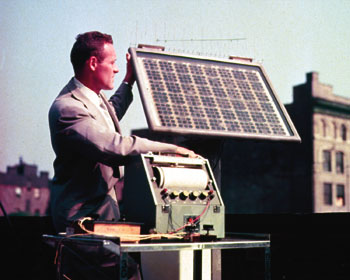To wrap up the series on solar PV, here’s a rundown of the science, brought to you by Alvaro. See this article if you’re looking for a practical introduction to solar PV.

Henri Becquerel. Image taken from saints.sqpn.com, via the New Catholic Dictionary. Date and photographer unknown.
In 1839, at age 19, a French physicist named A.E. Becquerel was experimenting with silver and platinum plates bathed in an acid. This amounts to something like your car battery. The surprise came when shining light on this battery seemed to produce a tiny bit more electricity that before. Neat, but how could he explain this?
For the next 80 years, hundreds of scientists experimented with this phenomenon. They called it the photoconduction (“light-increases-electricity”) effect. They tried and tried to reproduce it, using all manner of cocktails: selenium squashed between gold and brass, copper and lead coils with glass on top, and platinum sprinkled throughout it all. These experiments delivered very expensive and inefficient (less than 0.5%) solar cells by the 1930s.
The breakthrough came gradually over the 40 years that followed. A breed of materials came to light which weren’t quite metals, and weren’t quite insulators either. Plug in some electricity and nothing happens. Heat them a little, still nothing. In fact, most light didn’t do anything either. But each one was found to have a “sweet spot,” so if you gave them just the right electric current, they’d emit light. Heat them just right (or even hit them, just so!) and you get electricity. They are all different types of semiconductors.
The major discovery — the prototype of today’s solar module — was that by finding two semi-conductors with close “sweet spots,” you could make them work together efficiently without losing heat or electrons, maximizing the amount of current they generate. So when light from the sun bounces some electrons off material A, material B has just the right sweet spot to catch the electrons and channel them to the next cell, then the next one, and finally to a wire, through the_load, and back again to the solar panel. Even more exciting, one of these crystals was plain and cheap ground up sand, better known as silicon.

Bell Labs’ solar cell 1954
In the 70’s, semiconductors were engineered to have uber-precise sweet spots. These are more technically called band gaps. Some expensive crystals like Galium Arsenide have wider band gaps, and so can catch light of many different colors. They’re used in satellites and other ventures in which efficiency trumps cost. But the most common solar panels use cheap crystalline silicon. In photovoltaic panels, you’ll have two layers of c-Si. The top one has been sprinkled with phosphorous to widen the band gap in one “direction,” and the bottom one with boron. This process is called doping, and the important thing is that it primes one layer to throw an electron and the other layer to catch it. When electrons jump across the gap between these layers, shazam — you have current.
So that’s the basic science behind solar PV. Most thin film technologies work something like that as well.
With the next post, we’ll venture into a new technology, solar thermal. It’s much simpler, but no less fascinating. Stay tuned!